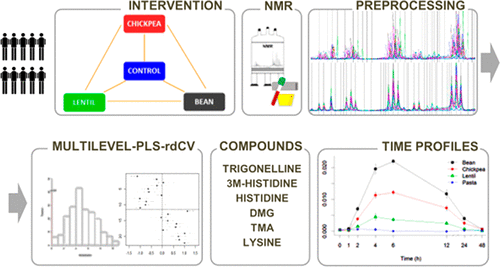当前位置:
X-MOL 学术
›
J. Agric. Food Chem.
›
论文详情
Our official English website, www.x-mol.net, welcomes your
feedback! (Note: you will need to create a separate account there.)
Untargeted 1H NMR-Based Metabolomics Analysis of Urine and Serum Profiles after Consumption of Lentils, Chickpeas, and Beans: An Extended Meal Study To Discover Dietary Biomarkers of Pulses
Journal of Agricultural and Food Chemistry ( IF 5.7 ) Pub Date : 2018-06-19 00:00:00 , DOI: 10.1021/acs.jafc.8b00047 Francisco Madrid-Gambin 1, 2 , Carl Brunius 3 , Mar Garcia-Aloy 1, 2 , Sheila Estruel-Amades 1 , Rikard Landberg 3, 4 , Cristina Andres-Lacueva 1, 2
Journal of Agricultural and Food Chemistry ( IF 5.7 ) Pub Date : 2018-06-19 00:00:00 , DOI: 10.1021/acs.jafc.8b00047 Francisco Madrid-Gambin 1, 2 , Carl Brunius 3 , Mar Garcia-Aloy 1, 2 , Sheila Estruel-Amades 1 , Rikard Landberg 3, 4 , Cristina Andres-Lacueva 1, 2
Affiliation

|
High legume intake has been shown to have beneficial effects on the health of humans. The use of nutritional biomarkers, as a complement to self-reported questionnaires, could assist in evaluating dietary intake and downstream effects on human health. The aim of this study was to investigate potential biomarkers of the consumption of pulses (i.e., white beans, chickpeas, and lentils) by using untargeted NMR-based metabolomics. Meals rich in pulses were consumed by a total of 11 participants in a randomized crossover study and multilevel partial least-squares regression was employed for paired comparisons. Metabolomics analysis indicated that trigonelline, 3-methylhistidine, dimethylglycine, trimethylamine, and lysine were potential, though not highly specific, biomarkers of pulse intake. Furthermore, monitoring of these metabolites for a period of 48 h after intake revealed a range of different excretion patterns among pulses. Following the consumption of pulses, a metabolomic profiling revealed that the concentration ratios of trigonelline, choline, lysine, and histidine were similar to those found in urine. In conclusion, this study identified potential urinary biomarkers of exposure to dietary pulses and provided valuable information about the time-response effect of these putative biomarkers.
中文翻译:

小扁豆,鹰嘴豆和豆类消费后尿液和血清谱的基于目标的1 H NMR代谢组学分析:一项扩展的膳食研究,发现豆类的饮食生物标志物
高豆类摄入量已被证明对人类健康具有有益作用。营养生物标志物的使用,作为自我报告调查表的补充,可以帮助评估饮食摄入量及其对人类健康的下游影响。这项研究的目的是通过使用基于NMR的非靶向代谢组学来研究豆类(例如白豆,鹰嘴豆和小扁豆)消费的潜在生物标志物。在一项随机交叉研究中,共有11名参与者食用了富含豆类的餐点,并采用了多级偏最小二乘回归进行配对比较。代谢组学分析表明,曲安奈林,3-甲基组氨酸,二甲基甘氨酸,三甲胺和赖氨酸是潜在的脉冲摄入生物标志物,尽管不是高度特异性的。此外,摄入后48小时内对这些代谢产物的监测表明,脉冲之间存在一系列不同的排泄方式。消耗了脉冲之后,代谢组学分析表明,曲安奈林,胆碱,赖氨酸和组氨酸的浓度比与尿液中的浓度比相似。总之,本研究确定了暴露于饮食脉冲的潜在尿液生物标志物,并提供了有关这些假定生物标志物的时间响应作用的有价值的信息。
更新日期:2018-06-19
中文翻译:

小扁豆,鹰嘴豆和豆类消费后尿液和血清谱的基于目标的1 H NMR代谢组学分析:一项扩展的膳食研究,发现豆类的饮食生物标志物
高豆类摄入量已被证明对人类健康具有有益作用。营养生物标志物的使用,作为自我报告调查表的补充,可以帮助评估饮食摄入量及其对人类健康的下游影响。这项研究的目的是通过使用基于NMR的非靶向代谢组学来研究豆类(例如白豆,鹰嘴豆和小扁豆)消费的潜在生物标志物。在一项随机交叉研究中,共有11名参与者食用了富含豆类的餐点,并采用了多级偏最小二乘回归进行配对比较。代谢组学分析表明,曲安奈林,3-甲基组氨酸,二甲基甘氨酸,三甲胺和赖氨酸是潜在的脉冲摄入生物标志物,尽管不是高度特异性的。此外,摄入后48小时内对这些代谢产物的监测表明,脉冲之间存在一系列不同的排泄方式。消耗了脉冲之后,代谢组学分析表明,曲安奈林,胆碱,赖氨酸和组氨酸的浓度比与尿液中的浓度比相似。总之,本研究确定了暴露于饮食脉冲的潜在尿液生物标志物,并提供了有关这些假定生物标志物的时间响应作用的有价值的信息。











































 京公网安备 11010802027423号
京公网安备 11010802027423号